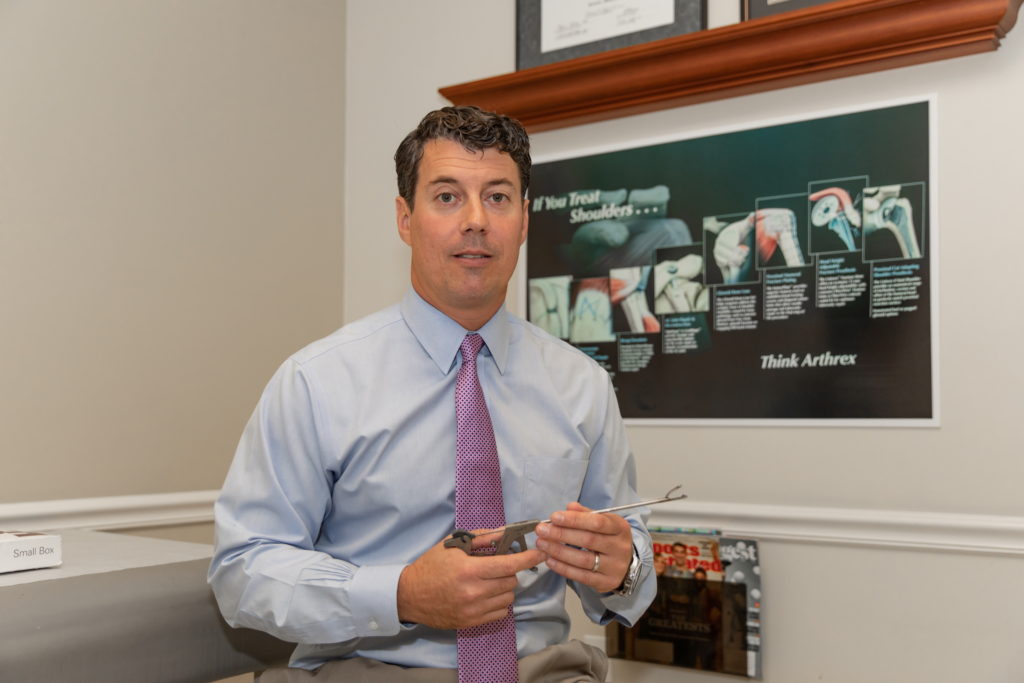Got an aching arm or shoulder? The culprit may be one or more of four muscles you’ve probably never even heard of – or it could just be the natural effects of aging.
Either way, Dr. Carl DiLella at the Orthopaedic Center of Vero Beach is someone who may be able to help.
“Most of my focus,” says the engaging DiLella, “is on the shoulder. That’s about 85 percent of my practice.”
Speaking softly, the 43-year-old fellowship-trained DiLella continues, “I’ve probably done more than 100 to 150 total shoulders” since arriving in Vero Beach back in 2015.
“Patients may have weakness or motion loss in their shoulder because of a lot of golf or tennis they’ve played over the years, and that can lead to soft tissue [muscle and tendon] problems. If they don’t respond, say, to therapy or a cortisone shot,” DiLella will likely turn his attention to what’s known as the rotator cuff.
According to Johns Hopkins Medicine, “the rotator cuff consists of muscles and tendons that hold the shoulder in place. It’s one of the most important parts of the shoulder. It allows you to lift your arm and reach up. An injury to the rotator cuff, such as a tear, may happen suddenly when falling on an outstretched hand or it may develop over time due to repetitive activities. Rotator cuff degeneration and tears may also be caused by aging.”
Yes, just getting older can lead to rotator cuff injuries.
As DiLella puts it, “it’s part of the aging process. As we age, the blood supply gets diminished and then tears can happen just from routine things. I mean, a lot of people think, ‘Oh I have to fall off a ladder to get a rotator cuff tear,’ but it doesn’t always happen that way. Mostly, the ones I treat are degenerative that happen over time.”
What’s more, bursitis, tendinitis, arthritis, fractures, infections, tumors and nerve-related issues can all contribute to rotator cuff and shoulder problems.
And those muscles you’ve probably never heard of?
They are the subscapularis, which is the muscle at the front of the shoulder that helps rotate your arm inwards; the supraspinatus and infraspinatus, which allow you to elevate or lift your arm; and the teres minor, a muscle at the back of the shoulder that helps rotate the arm outwards. DiLella says if there’s a tear or a complete detachment of any of those muscles or supporting tendons, “then we start talking about potentially [surgically] fixing it.”
The good news? Modern imaging techniques such as MRIs allow surgeons like DiLella to look for those tears or other damage from the outside in. No cutting required.
When asked if patients can tell on their own whether their shoulder problem will require rotator cuff surgery or even a shoulder replacement procedure, DiLella offers a quick response. “No,” he says, “they can’t.”
Such a diagnosis, he says, requires “a standard work-up, which includes history, radiographs that we show the patients from our X-ray machine, examining the patient, and then putting all the information together.
“Sometimes it’s as simple as an X-ray where I see bone-on-bone arthritis. Then the diagnosis is made without having to go into MRI or other things.”
Depending on what the work-up reveals, the patient may become a candidate for surgery.
And while no one relishes the idea of surgery, DiLella points out that his rotator cuff surgeries, like so many of today’s most advanced medical procedures, are done arthroscopically. That is, through a minimally invasive outpatient procedure using tiny cameras and miniaturized surgical instruments and very small incisions which DiLella says, takes “an hour to an hour and fifteen minutes to do.”
Vero Beach’s winter season is apparently ‘prime time’ for a variety of shoulder procedures including rotator cuff repairs, shoulder replacements and even ‘tennis elbow’ treatments.
Dr. Carl DiLella is with the Orthopaedic Center of Vero Beach at 1285 36th Street. The phone number is 772-778-2009.

